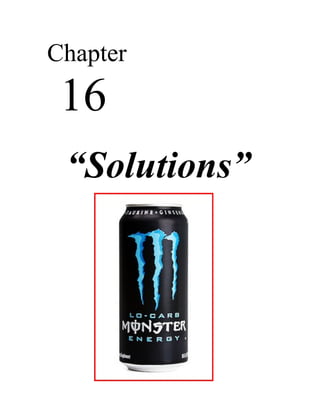
Chemistry - Chp 16 - Solutions - Notes
- 2. Section 16.1 Properties of Solutions OBJECTIVES: • Identify the factors that determine the rate at which a solute dissolves. • Identify the units usually used to express the solubility of a solute. • Identify the factors that determine the mass of solute that will dissolve in a given mass of solvent. Solution formation • The “nature” (polarity, or composition) of the solute and the solvent will determine… 1. 2. • Factors determining rate of solution... 1. 2. 3. Making solutions • In order to dissolve, the solvent molecules must come in contact with the solute. 1. _______________________________ moves fresh solvent into contact with the solute. 2. _________________________ pieces increase the amount of surface area of the solute. - think of how fast a breath mint dissolves when you chew it Temperature and Solutions 3. _______________________________________ makes the molecules of the solvent ________________________________ and contact the solute harder and more often. – Speeds up dissolving. • Higher Temperature ALSO Usually increases the amount that will dissolve (an exception is gases, more on that later).
- 3. Solids tend to dissolve best when: • They are ______________________ • They are ______________________ • Crushed into _________________________ particles Gases tend to dissolve best when: • The solution is ________________ • The __________________________________________ How Much? • Solubility- is the maximum amount of substance that will dissolve at a specific temperature. The units for solubility are: grams of solute/100 grams solvent 1) Saturated solution- Contains the maximum amount of solute dissolved. NaCl = 36.0 g/100 mL water 2) Unsaturated solution- Can still dissolve more solute (for example 28.0 grams of NaCl/100 mL) 3) Supersaturated- solution that is holding (or dissolving) more than it theoretically can; a “seed crystal” will make it come out; Fig. 16.6, page 475
- 4. Saturation and Equilibrium Supersaturated Example • Ever heard of “seeding” the clouds to make them produce rain? • Clouds - mass of air supersaturated with water vapor • Silver Iodide (AgI) crystals are dusted into the cloud as a “seed” • The AgI attracts the water, forming droplets that attract others
- 5. Liquids • Miscible means that two liquids can dissolve in each other – water and antifreeze – water and ethanol • Partially miscible- slightly – water and ether • Immiscible means they can’t – oil and vinegar Solubility? • For solids in liquids, as the temperature goes up-the solubility usually goes up • For gases in a liquid, the effect is the opposite of solids in liquids – As the temperature goes up, gas solubility goes down – Think of boiling water bubbling? – Thermal pollution may result from industry using water for cooling Section 16.2 Concentration of Solutions OBJECTIVES: • Solve problems involving the molarity of a solution. Concentration is... • a measure of the amount of solute dissolved in a given quantity of solvent • A concentrated solution has a large amount of solute • A dilute solution has a small amount of solute o These are qualitative descriptions • But, there are ways to express solution concentration quantitatively (NUMBERS!) Molarity: a unit of concentration • Molarity = • Abbreviated with a capital M, such as 6.0 M • This is the most widely used concentration unit used in chemistry.
- 6. Example Problem: Intravenous (IV) saline solutions are often administered to patients in the hospital. One saline solution contains 0.90 g NaCl in exactly 100mL of solution. What is the molarity of the solution?